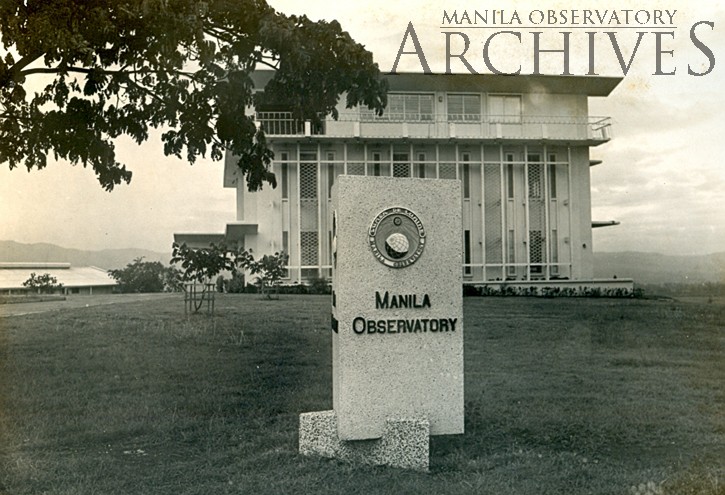Manila Observatory (Photo credit: MO Archives)
by Angel Hidalgo, S.J. and Victor Badillo, S.J.
Which were the main motivations of the Mathematics and Science professors of the Ateneo de Manila to take on additional work, placing upon their shoulders a new occupation: that of laying the foundations of the Manila Observatory? From the early stages, several are mentioned. Let’s take a look at these:
A. Geographical postion of the Philippines: in the course trajectory of tropical typhoons
The foundation of the Manila Observatory—says Fr. Algué—was out of need, for an eminently practical purpose. Philippine geography is a privileged one, almost unique for the study of the influence of natural phenomena has upon Earth. First, the terrible tempests have to be considered, which here are called “baguios”, constantly occurring in the Archipelago during half of the year spreading desolation. It was thus imperative to avoid such calamities by employing all possible resources. The main reason in the 1865 foundation of the Manila Observatory was due to this fact.
It was discovered at the very start that these fearful storms had its origin between the Eastern Carolines and the Philippines, with a translation movement toward the West; thus the Philippines with respect to the Asiatic Continent is a first wall of defence and tropical breakwater receiving the first assault. It is the lookout which perceives the first symptoms of these periodic turbulence becoming more devastating while advancing in its trajectory.
Manila is at the geographical center of the Archipelago where the consequences of almost all the typhoons of Western Pacific are felt. It was then necessary that an arterial net of meteorological stations be had to report immediately to the Manila Central the first signs of these atmospheric phenomena in order to coordinate the date and determine the position of the centers of perturbing depression. This was what was done: the greatest possible number of observation posts were established, in the Archipelago as well as in the Pacific, until it was possible to know the position of the storms with three or four days in advance. With these data, transmitted with the possible speed, the unforeseen surprises and sad consequences could be avoided in the whole Far East.
B. Study of the Philippine climate as a basis of agricultural and industrial development
Because of its insular distribution from North to South, the Philippines has a great variety of climates with a peculiar rule of rains for each region. It was, therefore, necessary an institution take charge of gathering and arranging the partial reports in order to know and make use of the fertility of each of them and thus obtain the greatest possible output.
This the Observatory tried to do. It generously offered in several publications all the collected data. Aside from the observed reports it offers orientations and practical advice that may help the progressive development of the Filipino soil.
C. The magnetic line passes near Manila
A new scientific reason was prompting the installation of an Observatory in Manila: its proximity to the magnetic line that crosses the Island of Mindanao, cutting the northern part of Davao Gulf and passing through the Balabac Strait, Sout of Palawan Island. The line of zero variation, where the earth’s meridian coincides with the magnetic line—or with the direction of the magnetic needle—passes thru Cape Bojeador, with inclination from ESE to WNW.
By reason of this position the ordinary variations of the magnetic needle are very regular. Because of this, the extraordinary variations appear very clearly, being this is high scientific value and very precious to the International Committee of Earth Magnetism.
D. Seismic movement of the Philippines terra firma
There is still another phenomenon requiring studious attention, because of its relative frequency in the Philippines: the earthquakes. The history of the Archipelago, and very specially of Manila, is filled with seismic tragedies.
As soon as it was possible, the Manila Observatory paid particular attention to the seismicity of the soil. So much so that the Philippines is one of the best known regions of the world in this matter. Several of the persons who have passed through the Observatory have attentively studied this theme; specially Fathers Saderra Masó, Miguel Selga and W. C. Repetti. Their works and surveys produced the publication of their conclusions and results with an abundant contribution of empirical data and observations.
E. The love of science
Other powerful reasons encouraged those young pioneers; the love of science in itself because of the attractive mystery it includes and the increase of knowledge. Besides, this personal inclination met the effective help of enthusiastic Superiors, which favored the stimulus of that same Science, by contributing with the ideological push, and providing them with the human means at their disposal.
These are, in general, the reasons that, since the beginning moved the establishment of the Manila Observatory. The latter centenary reality has shown the validity and the wisdom of such motivations.
Reference
This article was taken from Catalogue of Publications of the Manila Observatory Personnel by Angel Hidalgo, S.J. and Victor Badillo, S.J. (Quezon City, 1980), pp. 6-8.

